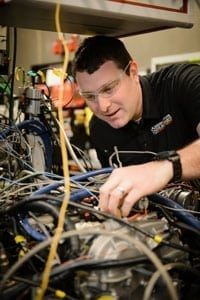Students turn 1991 Mazda into race car
March 12, 2015Work at CU-ICAR underscores state’s growing need for auto engineers
CLEMSON, SC – The sporty, white convertible was near the end of its life on the road until it was given to Dr. Robert Prucka and his student autocross team.
Now he and the team, CU-Racing, are turning the 1991 Mazda Miata into a race car.
Experts see the Clemson University project and others like it as crucial to producing a steady stream of engineering talent that will help recruit more automotive companies to the state.
Prucka and several members of the team will be available for photos, video and interviews on Thursday at 11:30 a.m. at the Clemson University-International Center for Automotive Research.
They are taking apart the whole vehicle, installing safety features and figuring out how to make it faster.
But it isn’t enough to drop a massive engine under the hood of the compact car to give it more power. Acceleration and handling win autocross races, which are typically held in parking lots and rarely go over 50 mph, Prucka said.
Prucka tries to replicate what students will face in the real world by making them justify big expenses. If they want to put a V8 engine in the Miata, they will need to show why it would make the car faster, he said.
“The project is a pretty overwhelming task, but it’s going to generate leaders in this industry,” Prucka said. “That’s why we do it. It makes them a better engineer all around. If you’re good with the hands-on activities and you’re good in the classroom, you’re going to get hired really quickly.”
About a dozen automotive engineering students joined the team and were working to get the Miata entered into a race before June. They have also brought in business students to help with the marketing.
When Prucka joined Clemson in 2008, the automotive engineering program was two years old. The department has grown to about 200 students and sends 94 percent of its alumni into the automotive industry or academia.
Dr. Zoran Filipi, the chair of the Department of Automotive Engineering, said Prucka has played a key role in building the program’s international reputation for excellence.
“Robert is an important part of the CU-ICAR ecosystem that connects the automotive industry to our faculty and students,” Filipi said. “His research is driven by a critical industry need, and his passion rubs off on students. Clemson is fortunate to have him.”
In a separate project, Prucka is working to develop sensors that could help solve some of the auto industry’s toughest engineering challenges.
What drives his research is a federal 2025 deadline that automakers face to sell a portfolio of cars and light trucks that average 54.5 miles a gallon. At the same time, the companies are under pressure to give buyers what they have come to expect from their cars– safety, performance, fun and affordability.
Prucka is sharply focused on one sensor in particular that he said could improve fuel economy by 1 to 2 percent at a relatively low cost to manufacturers.
“These changes can sound small, but 1 percent of the fuel used in the country is a lot of fuel,” he said. “It’s a lot of money. It’s a lot of CO2 emissions.”
When Prucka digs into the wires connected to the engine in the lab, he pays special attention to the EGR sensor. EGR stands for exhaust gas recirculation.
The sensor measures how much recycled exhaust gas is mixing with fresh air in the engine.
The information is fed into a computer, called the engine controller, that acts as the brains of the car. The computer can then use the data to control the EGR valve, making the the engine run more efficiently.
“Fuel economy is the No. 1 driver of our research,” Prucka said. “We’re trying to figure out how to better control these complicated engines, so we can gain that extra 1-2 percent fuel economy.”
The sensor research is funded by Bosch and the U.S. Department of Energy.
The work that Prucka and his team do have grabbed the attention of Dr. Tanju Karanfil, associate dean for research and graduate studies in the College of Engineering and Science.
“I am impressed by the level of scholarship and passion that Robert brings to his research and teaching,” Karanfil said. “His work is driven by industry needs and is helping consumers protect the environment and save fuel. We are lucky to have Robert here in South Carolina and in the College of Engineering and Science.”
Prucka is a faculty member in the Department of Automotive Engineering, which is part of the College of Engineering and Science. He and his team are based at CU-ICAR.

















